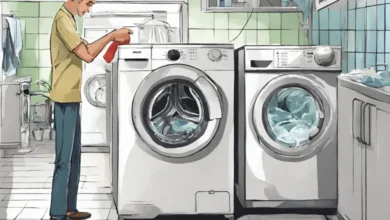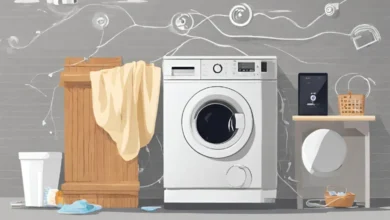Exploring Efficiency and Water Consumption: Fully Automatic vs. Semi-Automatic Washers

The laundry room is a hub of household chores, and the choice between fully automatic and semi-automatic washing machines plays a pivotal role in determining efficiency and water consumption. In this comprehensive exploration, we delve deep into the intricate workings of these two types of washers, analyzing the multifaceted factors that influence their efficiency, water usage, and overall environmental impact.
Understanding Fully Automatic Washers
1. Automation Features
Fully automatic washing machines, heralded for their convenience, operate seamlessly with minimal manual intervention. They boast a range of automated features, from automatic detergent dispensers to load sensing and diverse wash programs. These features collectively optimize the washing process, ensuring both time and resource efficiency.
2. Water Level Sensing Technology
A standout feature in fully automatic washers is their advanced water level sensing technology. This innovative system enables the machine to intelligently determine the precise amount of water required for each specific load. Consequently, this not only minimizes water wastage but also contributes significantly to the overall efficiency of the washing machine.
3. Energy Efficiency
Efficiency transcends water consumption to include energy usage. Fully automatic washers often incorporate energy-efficient technologies, such as inverter motors. These features not only reduce electricity consumption but also align with the broader goal of minimizing the environmental impact of household appliances.
Examining Semi-Automatic Washers
While fully automatic washers dominate the market, semi-automatic washers still maintain their relevance, especially in regions grappling with water scarcity. Let’s delve into the features that influence the efficiency of semi-automatic machines.
1. Manual Control and Water Management
Semi-automatic washers require manual input at various stages of the laundry process. Users need to fill the drum with water, move clothes between wash and rinse cycles, and drain water after each cycle. This manual control allows users to manage water usage more directly, adjusting it based on the load size and personal preferences.
2. Flexibility in Water Usage
Unlike fully automatic machines with predetermined water levels, semi-automatic washers offer users the flexibility to control water usage. This adaptability is beneficial in areas where water conservation is a top priority. Users can choose to use less water for smaller loads or when water resources are limited.
3. Initial Cost and Affordability
Semi-automatic washers are often more affordable than their fully automatic counterparts. While initial cost doesn’t directly impact water consumption or efficiency, it’s a factor that influences the overall decision-making process. The cost savings upfront might be appealing to budget-conscious consumers.
Also Read: Best Washing Machine in India
Efficiency in Practice
Now that we’ve examined the features of both types of washers, let’s consider how these features translate into real-world efficiency.
Fully Automatic Washer in Action
Fully automatic washers excel in load sensing, ensuring that the machine uses precisely the amount of water needed for a particular load. This feature prevents excessive water usage for smaller loads, contributing to water conservation. The availability of various wash programs in fully automatic washers allows users to tailor the washing process to specific fabric types and soil levels. This targeted approach minimizes the use of unnecessary resources, enhancing overall efficiency.
Automation not only simplifies the laundry process but also saves time. Fully automatic washers typically complete cycles faster than their semi-automatic counterparts, allowing users to accomplish more in less time.
Semi-Automatic Washer: Manual Control Benefits
Users have direct control over water usage in semi-automatic washers. This manual management is advantageous in scenarios where water conservation is paramount. Users can adapt to local water availability and restrictions, making these washers an excellent choice for environmentally conscious individuals.
Semi-automatic machines shine when dealing with smaller loads. Users can adjust water levels to accommodate the size of the laundry, preventing unnecessary water wastage for minor cleaning tasks. Some users prefer an extended rinse to ensure thorough removal of detergent residues. In a semi-automatic washer, this can be easily achieved by manually controlling the rinse cycle, contributing to a more efficient wash.
Water Conservation: A Key Consideration
Water scarcity is a global concern, making the water consumption aspect of washing machines increasingly critical. Let’s delve deeper into how each type of washer addresses this issue.
Fully Automatic Washers and Water Conservation
The advanced technology in fully automatic washers enables precise water consumption, aligning with the load size and wash requirements. This precision contributes significantly to water conservation efforts. Fully automatic washers often feature efficient rinse cycles that ensure thorough cleaning while minimizing the amount of water needed. This efficiency is crucial in regions facing water scarcity.
Many fully automatic washers come equipped with water-saving modes. These modes further reduce water consumption by optimizing the entire washing process, from initial filling to final rinse.
Semi-Automatic Washers: Manual Control for Conservation
The manual control provided by semi-automatic washers allows users to define water levels based on the load size. This adaptability is particularly advantageous for users seeking to minimize their environmental impact. Some users adopt a practice of reusing rinse water for subsequent wash cycles in semi-automatic machines. While this requires manual effort, it adds an extra layer of water conservation to the laundry routine.
Environmental Impact and Sustainability
As environmental consciousness grows, consumers are increasingly considering the sustainability of their household appliances. Let’s assess how both fully automatic and semi-automatic washers contribute to a greener lifestyle.
Fully Automatic Washers: Embracing Sustainable Technologies
Fully automatic washers often incorporate energy-efficient technologies, such as inverter motors. These features not only reduce electricity consumption but also align with the broader goal of minimizing the environmental impact of household appliances. The automation in fully automatic washers extends beyond water usage to overall resource optimization. Smart features, like load sensing and detergent dispensing, contribute to a more sustainable laundry routine.
While the initial cost of fully automatic washers might be higher, the long-term cost savings in terms of energy efficiency and resource conservation can make them a financially and environmentally sound investment.
Semi-Automatic Washers: Budget-Friendly and Resource-Conscious
The lower initial cost of semi-automatic washers makes them accessible to a broader consumer base. This affordability aligns with sustainability by offering an eco-friendly option to users with budget constraints. The manual control features of semi-automatic washers empower users to adopt green practices, such as reusing rinse water and minimizing detergent usage. These practices contribute to a more environmentally conscious approach to laundry.
Conclusion
In the realm of washing machines, the choice between fully automatic and semi-automatic models involves a careful consideration of various factors. While fully automatic washers shine in terms of convenience, speed, and advanced technologies, semi-automatic washers offer a more hands-on approach, allowing users to manage water usage directly. The decision ultimately depends on individual preferences, budget constraints, and the commitment to environmental sustainability. Whether opting for the advanced automation of fully automatic washers or the manual control benefits of semi-automatic ones, both choices play a role in shaping a household’s ecological footprint.






